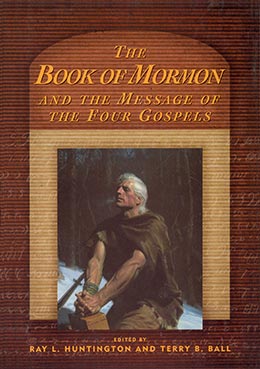Introduction
Why the Book of Mormon?
The Bible is a wonderful book of scripture. Indeed, it has blessed the lives of countless men and women throughout the ages and has caused men such as Daniel Webster to state that it is “a book of faith, and a book of doctrine, and a book of morals, and a book of religion, of special revelation from God.” [1] Other great individuals, such as President Ezra Taft Benson, have expressed love and appreciation for the Old and New Testaments, since the Bible “teaches us about the life and ministry of the Master. From its pages we learn of the hand of God in directing the affairs of His people from the very beginning of the earth’s history. It would be difficult to underestimate the impact the Bible has had on the history of the world. Its pages have blessed the lives of generations.” [2]
Yet, as the prophet Nephi foresaw, after the writings contained in the Bible would go forth by the hand of the twelve apostles of the Lamb, many plain and precious truths would be taken from the Bible by the great and abominable church (see 1 Ne. 13:26). Elder Bruce R. McConkie stated that “Satan guided his servants in taking many plain and precious things, and many of the covenants of the Lord, from the Bible.” [3] The removal of those precious truths had, and continues to have, a profound effect on God’s children. For example, Nephi learned from a heavenly messenger that the great and abominable church removed the plain and precious truths in order to “pervert the right ways of the Lord, that they might blind the eyes and harden the hearts of the children of men” (see 1 Ne. 13:27). In the same vision Nephi further learned that “because of these things which are taken away out of the gospel of the Lamb, an exceedingly great many do stumble, yea, insomuch that Satan hath great power over them,” such that they are in an “awful state of blindness” (1 Ne. 13:29, 32). Many of the individuals who are in this “awful state of blindness” are humble, devout, believing Christians who are led to err and stumble as a result of important truths that have been removed or altered from the original text of the Bible. Indeed, those honest men and women are much less secure in the salvation of Jesus Christ than they deserve to be as a result of the loss of those vital truths. [4] The young Joseph Smith also found himself in the midst of confusion and strife while seeking to find which church was right, since “the teachers of religion of the different sects understood the same passages of scripture so differently as to destroy all confidence in settling the question by an appeal to the Bible” (JS-HL12).
Through an extraordinary vision, the prophet Enoch learned that in the latter days the Lord would send righteousness down from heaven and truth from out of the earth (see Moses 7:62). President Ezra Taft Benson stated that we have seen the marvelous fulfillment of this prophecy through the coming forth of the Book of Mormon, since the sacred record came forth from out of the earth. [5] The Book of Mormon contains many plain and precious truths taken from the Bible (see 1 Ne. 13:34–35). The Lord refers to those truths as his “gospel,” his “rock,” and his “salvation” (1 Ne. 13:36). Thus, “part of the flood of light that accompanied the Restoration was the return of these lost truths.” [6] When used in conjunction with the Bible, the Book of Mormon clarifies and restores precious truths regarding such doctrines as the Godhead, the resurrection and the nature of resurrected beings, the final judgment, the priesthood, and the Fall. It is no wonder, then, that President Benson taught that the Book of Mormon needs to be “enthroned in the minds and hearts” of the Latter-day Saints. [7]
While there could be a great deal written on the Book of Mormon’s clarification and restoration of missing truths from the texts of the Old and New Testaments, this volume will focus only on the four Gospels—Matthew, Mark, Luke, and John. The purpose of the chapters in this book is to illuminate and clarify through the Book of Mormon many of the important doctrines and concepts found in the Gospels. Our hope is that the reader will better understand New Testament doctrine through the clarifying lenses of the Restoration.
We would like to thank the authors who have contributed to this volume. We also express our thanks to Kent P. Jackson of BYU’s Religious Studies Center and to his staff: Tami Andelin, Rozalyn M. Bird, Jason W. Hughes, Peter M. Jasinski, Amy E. Jensen, Brenda B. Johnson, Charlotte A. Pollard, Heidi Poulson, H. L. Rogers, Randall R. Rogers, Jason O. Roberts, and Robert F. Schwartz.
Notes
[1] Daniel Webster, as quoted in Dictionary of Quotable Definitions, ed. Eugene E. Brussell (Englewood Cliffs, N. J.: Prentice Hall, 1970), 48.
[2] Ezra Taft Benson, A Witness and a Warning (Salt Lake City: Deseret Book, 1988), 23.
[3] Bruce R. McConkie, The Millennial Messiah (Salt Lake City: Deseret Book, 1982), 164.
[4] Jeffrey R. Holland, “Rending the Veil of Unbelief,” in Nurturing Faith Through the Book of Mormon: The 24th Annual Sidney B. Sperry Symposium (Salt Lake City: Deseret Book, 1995), 3.
[5] Benson, 26
[6] Neal A. Maxwell, A Wonderful Flood of Light (Salt Lake City: Bookcraft, 1990), 24.
[7] Benson, 26.
